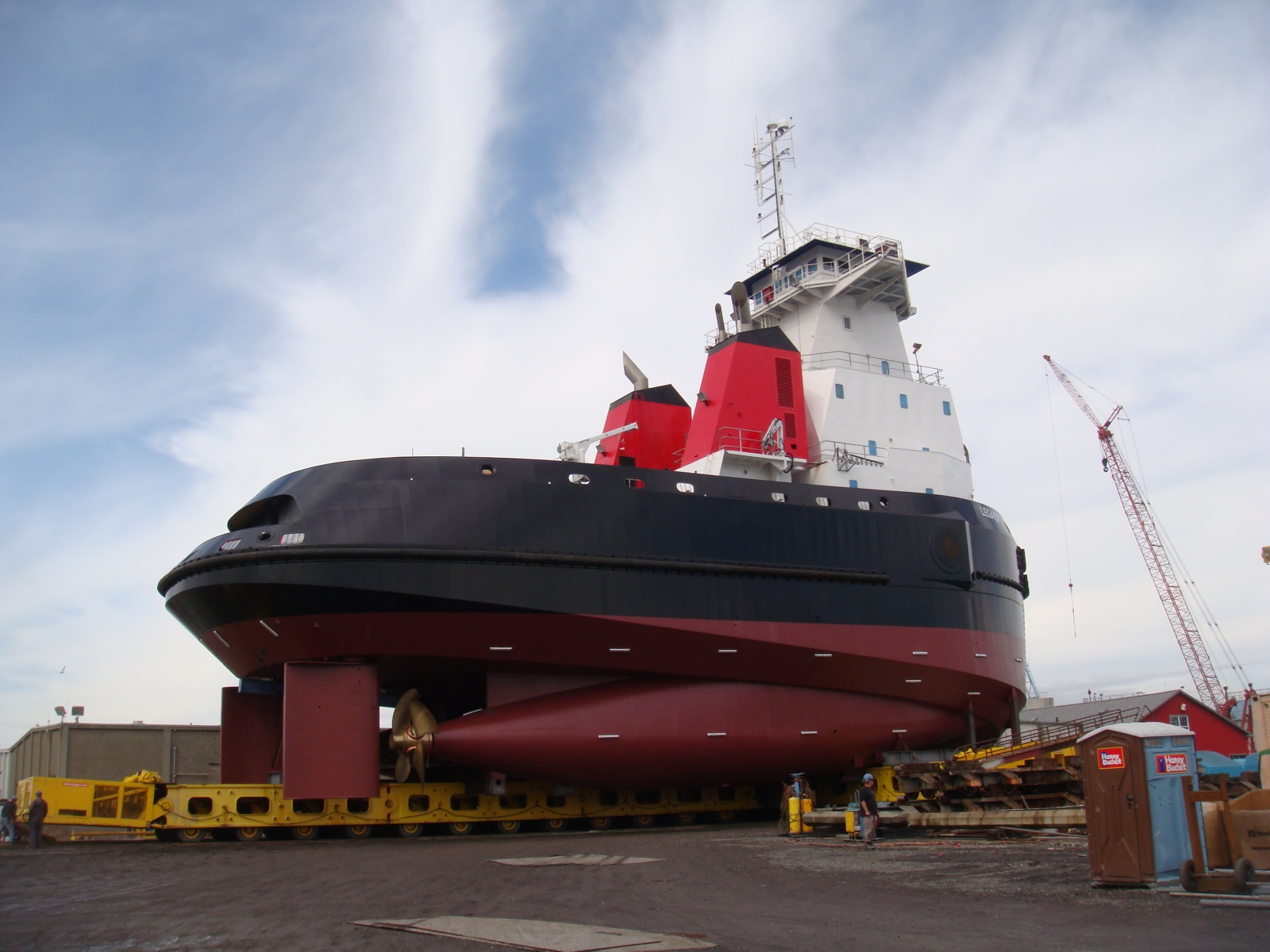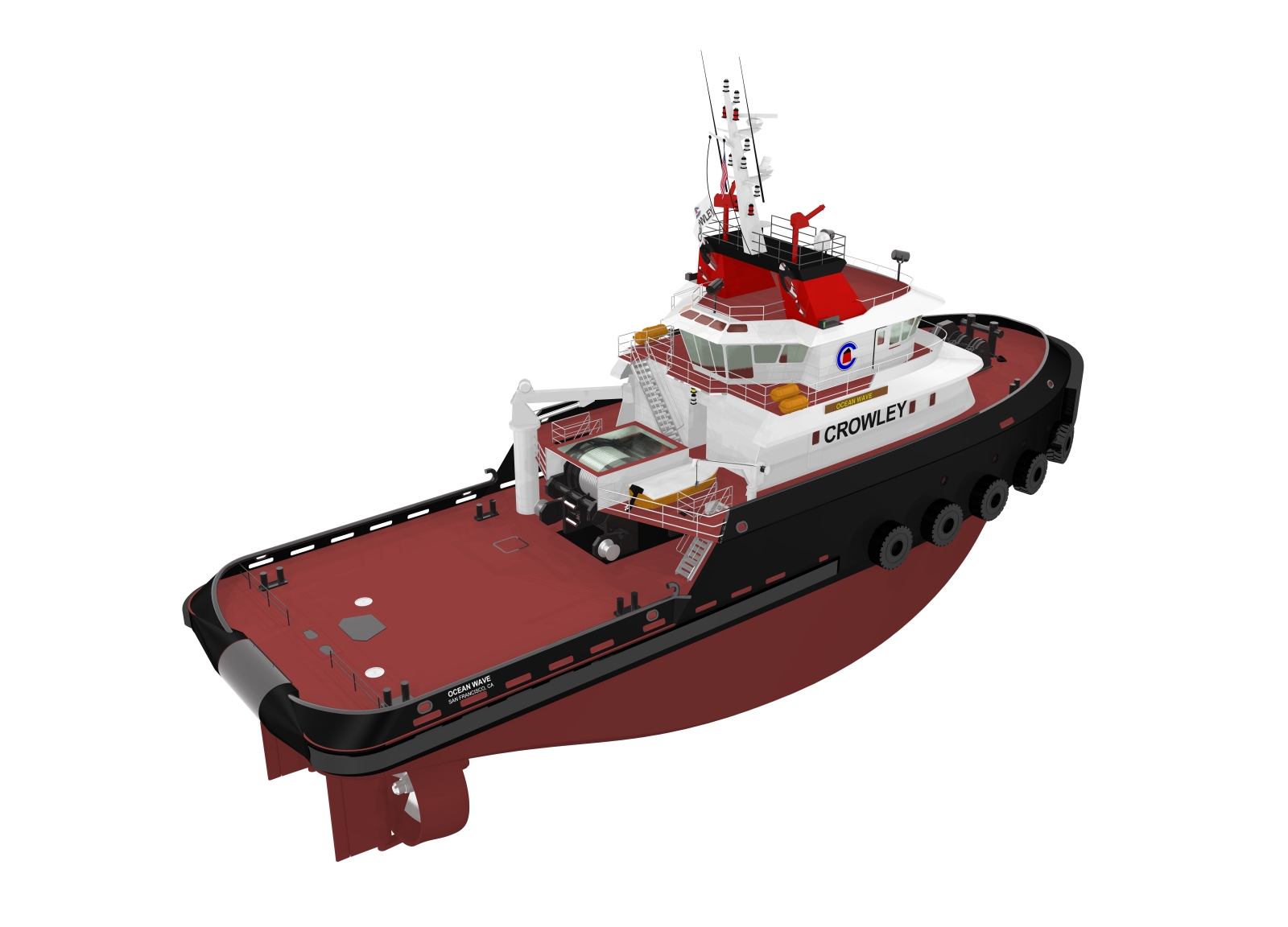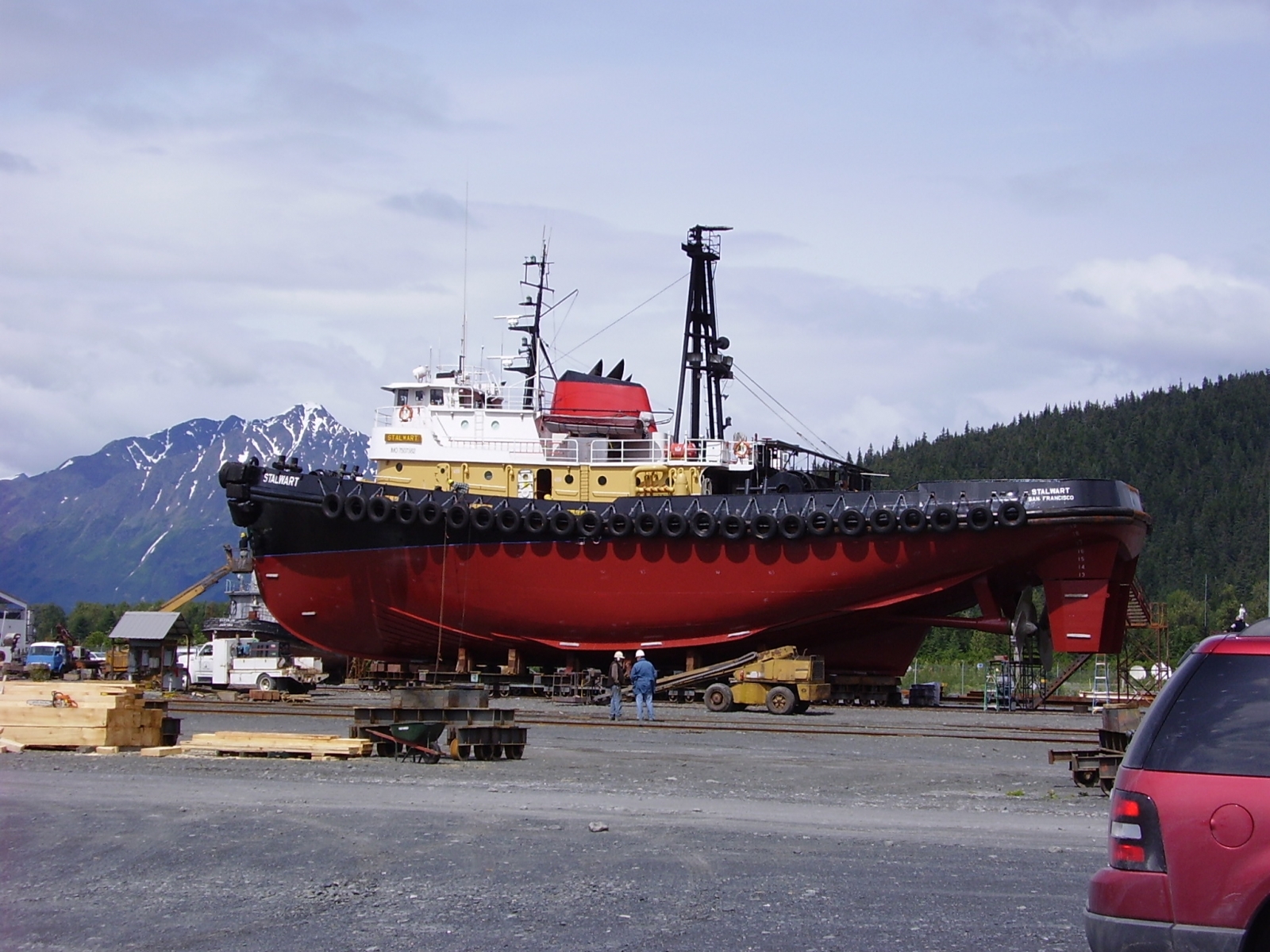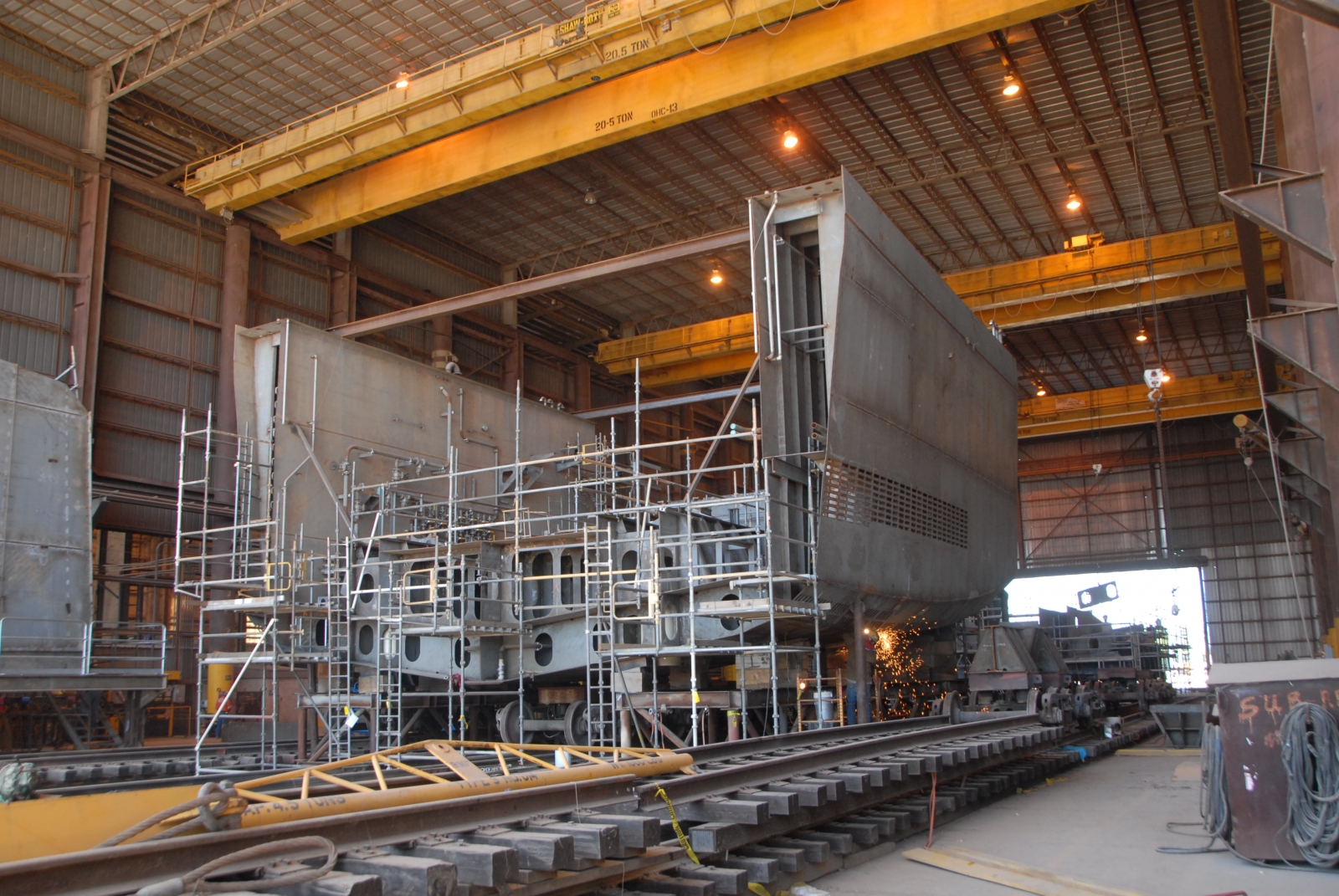Since Crowley Maritime began its fleet modernization program in 2002, size, performance and impact on the environment of each new class of vessel have grown bigger, grown faster and grown greener.
 |
|
Legacy, the first of three 750-class ATB tugs, nears completion at Dakota Creek Industries. (Photo courtesy Crowley Maritime)
|
First out were four of the 550-series of ATB units, followed by the 650-series in 2006, with the 10th and last, Vision-10, expected to be delivered later this year. Now the Jacksonville, Fla.-based company has started the 750 series, three ATB units that are expected to be the biggest and fastest of their kind in the country. Even better, for tugboat enthusiasts and potential customers, construction began this year on the first of four Ocean-class tugs that the company expects will mark it as leaders in the ocean-towing field for some time.
The 127-foot, 550 ATBs, beginning with Sea Reliance and followed by Sound Reliance, Ocean Reliance and Coastal Reliance are 9,280-hp tugs propelled by Caterpillar 3512-B diesels, Reintjes reduction gears and Rolls-Royce 12-foot diameter propellers. These tugs push dedicated 512-foot, 155,000-bbl barges at speeds up to 12 knots.
The first two tugs and barges were built at Halter Marine, in Moss Point, Miss. After Halter went bankrupt, the last two boats were built at Marinette Marine in Wisconsin, and the barges were constructed at Bay Shipbuilding, in Sturgeon Bay, Wis. Halter subsequently went through a few restructurings and emerged as VT Halter Marine, after which Crowley signed them to build the 650 series of tugs and barges.
In 2006, the 650-class was introduced with the 127-foot Pacific Reliance and Gulf Reliance, pushing 587-foot, 185,000-bbl barges. "We built the boats in this series identical to the first four boats," said Ed Schlueter, vice president of vessel management services for Crowley.
Schlueter explained that they lengthened the barges for the 650s, and increased their capacity to 185,000 barrels by adding an extra tank to the center of the 155,000-bbl barges.
 |
|
Ocean wave, in a concept drawing, is under construction at Bollinger Marine Fabricators. (Photo courtesy Jensen Maritime Consultants)
|
Then, for the next eight boats in the series, Crowley switched to heavy-fuel oil (HFO) Wärtsilä engines to take advantage of the much lower cost of that fuel. Those tugs, in order of delivery, are Resolve, Integrity, Courage, Commitment, Pride, Achievement, Innovation and soon, Vision. However, all of the HFO boats have the ability to switch to light fuels in order to comply with near-coast operations and port entry regulations.
Heavy fuel is cheap, but building a boat to HFO requirements is not. More tankage is needed to store different batches of the thick fuel, as well as having tanks for the low sulfur, light fuel. There is also a great deal more complexity involved in the processing of HFO that requires equipment to heat the oil and atomize it for burning. Extra crewing also comes into play.
"In order to get that done, we lengthened the boats to 135 feet to get the HFO support systems into them. But the barges remained identical," said Schlueter. All of that extra money was justified, he said, because the company has realized significant fuel cost savings as a result.
Both the 550s and the 650s employ an Intercontinental Engineering (Intercon) coupling system to lock the tug into a notch in the stern of each barge. The coupler has a 50-inch diameter pin that engages with ladders built into the side of the barge notch.
The newer ATBs in the 650 series have pins that are narrower than the earlier ones that, when rotated, can move up and down in the notch without disengaging from the barge. The modification was made because Crowley's ATBs are often lightering a ship at sea or transfering fuel at certain docks that require the tug to remain in the notch. The new style of pin allows the tug to keep a static position as the barge rides higher or lower in the water as the tanks are emptied or filled.
By late this year, Vision, the last of the 650s, will lock into the notch of its barge and head out to sea. Each barge is named with a dash and numbered to correspond with the sequence of tug deliveries. Although all of the 14 tugs and barges in each series are married to each other, they are interchangeable if they are separated for whatever reason. But those of the first two classes are not compatible with the 750 series.
"The 750s are very large, so much bigger, with the 330,000-bbl barges, that they're not interchangeable with the other series," said Schlueter.
In late 2011, the first of three 750-class ATB units, Legacy, a 148-foot tug with 60 foot beam, coupled to a 600-foot, 330,000-bbl barge is scheduled to join the Crowley fleet. Legend and Liberty will follow. The tugs are being built at Dakota Creek Industries, in Anacortes, Wash. and the barges are being built at VT Halter Marine, in Pascagoula, Miss.
 |
|
Crowley's fleet of Invader-class tugs, like Stalwart, pictured here, are true displacement hulls with loaded draft of 20 feet, a pair of 20-cylinder EMD engines generating 75 tons of bollard pull. Stalwart can be seen here with more than 50 large tires for fendering. (Brian Gauvin photo)
|
The 16,320-hp tugs, designed by Naviform in Vancouver, B.C., have totally separate engine rooms, essentially a power train housing that is called a propulsion pod. Each pod contains an 800-hp Wärtsilä C32 HFO-capable main engine, Wärtsilä reduction gears, and a shaft generator and shaft running aft to a controllable-pitch (CP) propeller. The tugs will have redundant steering systems and over-sized rudders. They are expected to achieve a speed of 15 knots.
"We're one of the first companies to get an ABS redundant engine room rating, an R2 rating, on such a vessel," said Schlueter. The three Jones Act ATBs will also meet SOLAS and full ABS requirements.
While under way, the vessel's electrical requirements will be supplied by the shaft generators. While in port, a third generator will supply the hotel power. Intercon has built a larger, 64-inch pin coupling system to handle the bigger barges.
All of Crowley's ATBs are built under the ABS SafeHull program for environmental protection. This program puts the vessel design through an exhaustive review to identify structural loads and strengthen the vessel structure.
The barges for the 750s are designed to carry petroleum products, heated cargoes and EZ chemicals. They will have a fixed cleaning system for handling the cargo changes and a dual-mode inert gas and vapor collection system.
All this attention to safety and the environment and crew safety and comfort is not a haphazard process. It is driven by a desire to get ahead of expected, and costly, future regulations. And, according to Schlueter, Crowley is basing everything on running the boats for the next 30 years.
"When you look back 10 or 25 years ago and realize what the environmental issues were, then you fast forward to today and try to figure out what the situation is going to be 30 years from now, it's just going to be staggering," said Schlueter. "There's a lot of educated guessing — emissions, noise pollution, water pollution. We're trying to get out in front of the curve."
Which brings us to Crowley's latest ambitious building program: four Ocean-class tugs, designed by the Crowley subsidiary company, Seattle-based, Jensen Maritime Consultants, and under construction at Bollinger Marine Fabricators, of Amelia, La. The first, Ocean Wave, is scheduled for delivery by late 2011, followed by Ocean Wind, Ocean Sky and Ocean Sun in 2012. The 10,880-hp tugs will be among the most powerful tugs in the U.S.
The boats are expected to work primarily in the Gulf of Mexico, and are ideally suited to Crowley's 455 series of 400-foot ocean barges. But Schlueter points out that they are general-purpose tugs that will be called upon to tow anything anywhere over the course of their lives. He went on to explain that Crowley's customers were looking for a minimum of 120 tons of bollard pull, enough muscle to tow their drilling rigs, barges and a variety of deck loads needed for assembling deepwater rigs offshore.
Crowley went further and set a goal of 150 tons minimum bollard pull in order to remain competitive over time. When finally introduced, the tugs are expected to have as much as 165 metric tons of pull, according to Crowley. Producing all that pull are two Caterpillar C-280-12 diesels, with Reintjes LAF 5666 reduction gears and 154-inch, four-blade, CP propellers.
The tugs will have sophisticated software that provides preferential load sharing for running the fire pumps, shaft generators, bow thrusters and CP propellers at the same time. "The scariest thing is that all of the capability of that software comes in a little box the size of a cigarette package," said Schlueter.
Industry regulation is not expected to diminish, so the company chose light fuel diesel engines to hedge against increasing air pollution rules in the future. The Caterpillar engines are Tier II, as required now, but they are configured to allow for upgrading to Tier III and Tier IV as regulations are stiffened in the future.
 |
|
Crowley's fleet of Invader-class tugs could ultimately be replaced by Ocean-class tugs, now under construction. (Brian Gauvin photo)
|
"There is enough room designed into the boats so that when the technology is available we can take off the stacks and pull out the silencers, and install the new equipment that will get us to Tier III and eventually to Tier IV," said Schlueter.
The vessels are double-hulled and designed to prevent overboard discharges of fuel or fluids. They will be DP-1 and FiFi-1, as is becoming expected in the oil field service market.
Intercon, based in Kansas City, Mo., still manufactures its winches and couplers in the heartland. The company has a long and solid relationship with Crowley, and is building a whole new winch system for these four tugs. Although based on their 600-hp, hydraulic, DW275H double-drum waterfall winch, some dramatic modifications are being made, not the least of which is reversing the drums in order to lower the vessel's center of gravity.
The winch weighs 114 tons with 4,200 feet of 2.75-inch wire on the towing drum, typically the upper drum, and 3,000 feet of 2.25-inch wire on the second drum, typically the lower drum. The reverse waterfall winch flips the weight distribution by placing the towing drum on the bottom, thereby contributing to a lower center of gravity. The reverse waterfall is also under-wound as opposed to over-wound on the standard unit. The result is that the wire runs off the drum closer to the deck, resulting in a straighter vertical lineup with the shark jaws and other towing gear. The towing winch has a pulling power of 500,000 pounds according to Intercon.
Crowley also chose a waterfall style of winch rather than a side-by-side double-drum arrangement because the wire runs straighter off the drum through the shark jaws and towing pins straddling the centerline of the aft deck. With each ship-set, Intercon is also supplying an ESW-125D windlass mooring winch and a 21-inch capstan for the bow. Another modification, intended to keep crewmembers away from wires under tension, is installation of wheelhouse winch controls that also have a touch screen information panel.
"We take the comfort of the crew very seriously," said Schlueter. "The boat is a home. If we can provide a better place, they will take a lot more interest in the boat and the boat's maintenance. We try to get the best people so we try to get them the best boat." To that end, the engines have resilient engine soft mounts, the staterooms have extra padding and each crewmember has his own flat screen television and Internet access.
Crowley expects the new vessels will establish them as industry leaders for many years, keeping the company competitive as much as its Invader class has for several generations. "They were our signature boats for years. So we're looking to the Ocean class to be our signature boat for the next 30 years. We're going to be proud of these boats 30 years from now," said Schlueter.


